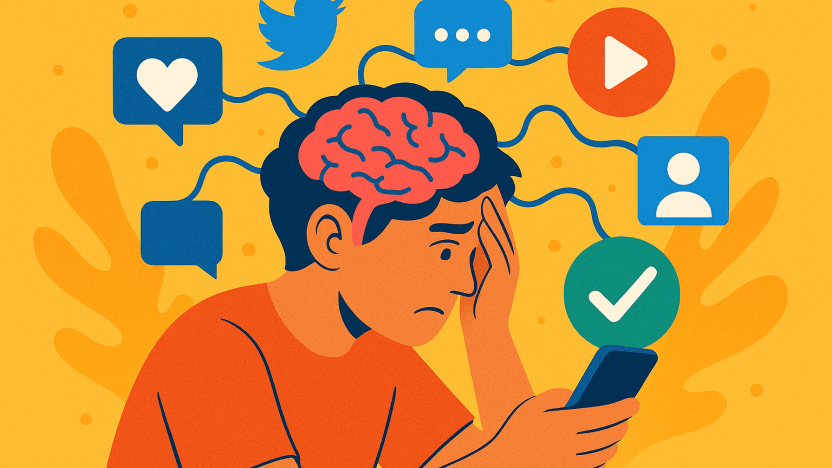The digital age has brought an unexpected side effect: “brainrot” – a modern phenomenon describing the mental fog and cognitive decline resulting from constant social media exposure. This digital drain manifests as decreased attention spans, scattered thinking, and mental exhaustion.
Social media platforms bombard users with an endless stream of information, creating a cognitive overload that reshapes how our brains process information. The human mind, designed for deeper connections and focused attention, now struggles to adapt to the rapid-fire content delivery of platforms like TikTok, Instagram, and Twitter.
The impact of excessive digital engagement extends beyond mere distraction:
- Altered brain chemistry from constant dopamine hits
- Reduced ability to form meaningful connections
- Compromised critical thinking skills
- Disrupted sleep patterns
- Increased anxiety and stress levels
Understanding these effects has become crucial as social media usage continues to rise. Young minds are particularly vulnerable, with research showing significant changes in brain development among heavy social media users. The cognitive consequences of this digital immersion affect everything from academic performance to emotional well-being.
As we navigate this increasingly connected world, recognizing the signs of digital overload becomes essential for protecting our mental health and maintaining cognitive clarity.
Understanding Brainrot
Brainrot is a modern psychological phenomenon characterized by persistent mental exhaustion and diminished cognitive function. This condition arises from prolonged exposure to rapid-fire digital content, creating a state where the brain struggles to process and retain meaningful information.
Signs of Brainrot
The signs of brainrot often appear subtly:
- Decreased attention span – Difficulty focusing on tasks requiring sustained concentration
- Information overload – Feeling overwhelmed by simple decision-making processes
- Mental fog – Reduced clarity in thinking and problem-solving abilities
- Emotional numbness – Diminished emotional responses to meaningful life events
- Compulsive checking – Unconscious reaching for devices, even during important activities
Psychological Impact of Cognitive Overload
The psychological impact of this cognitive overload extends beyond temporary discomfort. Research indicates that constant digital stimulation alters neural pathways, affecting how we:
- Process information
- Form memories
- Experience emotions
- Engage in deep thinking
These changes can lead to a cycle of diminishing mental capacity, where the brain adapts to shallow processing modes and loses its ability to engage in deeper analytical thinking. The brain’s natural filtering mechanisms become overwhelmed, leading to decision fatigue and reduced cognitive performance in daily tasks.
Stress Responses Triggered by Cognitive Strain
Recent studies suggest that this cognitive strain can trigger stress responses in the brain, releasing cortisol and other stress hormones that further impair memory formation and emotional regulation. This creates a feedback loop where mental fatigue leads to increased stress, which then compounds the effects of cognitive overload. It’s crucial to protect your brain from stress, as these stress responses can have long-lasting effects on our overall well-being. Furthermore, understanding the underlying mechanisms of these changes may help us develop strategies to mitigate their impact, such as those discussed in this scientific study.
The Science Behind Social Media and Its Impact on the Brain
Recent studies in neuroscience have shown how social media can change the way our brains work. Using brain imaging techniques, researchers have found that heavy users of social media experience significant changes in the prefrontal cortex, which is the part of the brain responsible for making decisions and controlling impulses.
Neural Pathways and Dopamine
The brain’s reward system responds to social media interactions similarly to addictive substances:
- Each notification triggers a dopamine release
- “Like” notifications activate the same neural circuits as winning money
- The constant reward-seeking behavior creates addiction-like patterns
- Rapid-fire content consumption alters attention-related neural pathways
The Role of Age in Brain Development
Young brains are more vulnerable to the effects of social media. Research has shown that during adolescence, there are certain changes happening in the brain that make individuals more susceptible:
- Increased sensitivity to social rejection
- Enhanced reward-seeking behavior
- Reduced impulse control
- Altered emotional processing
Additionally, there are critical periods in brain development where exposure to social media can have long-lasting effects:
- Ages 12-25 show maximum neural plasticity
- Social media exposure during these years can permanently alter brain structure
- Memory formation and attention spans face significant impact
Brain scans of teenage social media users reveal concerning patterns:
“Adolescents who spend >3 hours daily on social media show reduced gray matter volume in areas controlling memory and emotional regulation” – Journal of Neural Development, 2022
Age-Related Response Differences
Different age groups process social media stimuli uniquely:
- Teens (13-19):
- Heightened sensitivity to peer feedback
- Stronger activation of reward centers
- Reduced activity in impulse control regions
- Young Adults (20-25):
- Moderate sensitivity to social validation
- Better emotional regulation
- Improved impulse control compared to teens
- Adults (26+):
- Lower susceptibility to peer influence
- More stable reward processing
- Better balanced emotional responses
Research indicates that early exposure to intensive social media use can create lasting changes in neural pathways, potentially affecting cognitive development well into adulthood. These alterations may influence everything from attention span to emotional regulation capacity.
The brain’s ability to adapt and change, known as neuroplasticity, makes it particularly susceptible
Daily Habits and Social Media Usage
Recent data reveals alarming statistics about our digital consumption habits. The average adult spends 3.5 hours daily on social media platforms, with Generation Z users reaching up to 4.5 hours per day. These numbers exclude work-related screen time, painting a picture of unprecedented digital immersion.
The Notification Trap
- Push notifications interrupt users an average of 63.5 times per day
- Each interruption requires 23 minutes to regain full concentration
- Users check their phones 58 times daily, with 30 checks occurring during work hours
The constant stream of notifications creates a perpetual state of divided attention. Our brains, designed for single-task focus, struggle to maintain productivity under these conditions. Research shows that people who frequently switch between tasks experience a 40% reduction in productivity compared to those who maintain focused work sessions.
The Nature of Social Media Content
Modern social platforms prioritize quick, digestible content formats:
- 15-30 second video clips
- Rapid-scroll feeds
- Bite-sized text posts
- Endless content streams
These short-form interactions reshape our cognitive patterns. Users develop a decreased tolerance for longer content formats, leading to:
- Reduced ability to engage with complex ideas
- Difficulty maintaining sustained attention
- Decreased comprehension of nuanced topics
Traditional vs. Digital Communication
Traditional forms of communication foster deeper cognitive engagement:
| Traditional Media Social Media Extended focus periods | Fragmented attention |
| Linear information processing | Non-linear consumption |
| Active engagement | Passive scrolling |
| Deliberate pace | Rapid content switching |
The brain’s adaptation to quick-hit content creates a feedback loop: as attention spans shrink, content becomes increasingly condensed. This cycle reinforces shallow engagement patterns, making it progressively harder to engage in deep thinking activities.
Studies indicate that readers of traditional printed materials retain 65% more information compared to social media consumers. The physical act of reading from paper activates different neural pathways, promoting deeper information processing and better long-term retention.
Symptoms and Consequences of Brainrot
Brainrot affects both behavior and thinking in noticeable ways. People with brainrot often show:
Shortened Attention Spans
- Difficulty focusing on tasks beyond 2-3 minutes
- Constant urge to switch between activities
- Restlessness during longer conversations
Emotional Disruptions
- Increased anxiety levels when separated from devices
- Mood swings triggered by social media interactions
- Heightened sensitivity to online feedback
- Social comparison leading to self-esteem issues
Cognitive Decline
- Reduced ability to process complex information
- Struggle with deep reading comprehension
- Impaired critical thinking skills
- Weakened memory retention
Studies show that these symptoms can develop into long-lasting changes in thinking. The brain’s reward system gets rewired, resulting in:
- Decreased problem-solving abilities
- Impulsive decision-making tendencies
- Reduced analytical thinking skills
- Difficulty maintaining meaningful relationships
Young adults often report feeling “brain fog” and mental exhaustion after spending long periods on social media. This mental fatigue affects their academic performance, work productivity, and personal growth. The constant influx of fragmented information leads to a cycle of shallow thinking patterns, making it hard to engage in deep and meaningful thought processes.
Moreover, research has indicated that conditions like rheumatoid arthritis (RA) can also have profound effects on cognitive functions. This highlights the importance of addressing not just the physical but also the mental health aspects of such diseases.
Recovery from Brainrot
The path to cognitive wellness requires active engagement in mindful practices and lifestyle adjustments. Research shows that physical exercise stimulates neuroplasticity, helping the brain create new neural pathways and strengthen existing ones. A 30-minute daily workout can enhance memory, focus, and mental clarity.
Creative activities serve as powerful antidotes to brainrot:
- Art and Music: Drawing, painting, or playing an instrument engages different brain regions
- Writing: Journaling or creative writing promotes deep thinking and emotional processing
- Hands-on Crafts: Activities like woodworking or gardening build neural connections
Face-to-face interactions provide irreplaceable benefits for brain health. Real-world conversations involve complex social cues, emotional intelligence, and active listening – skills that diminish with excessive social media use.
Practical Tips for Managing Social Media Use
Creating a balanced digital lifestyle starts with structured boundaries:
- Set Screen-Free Zones
- Designate tech-free spaces in your home
- Keep devices out of the bedroom
- Practice device-free meals
- Time-Based Limits
- Use app timers to track usage
- Schedule specific hours for social media
- Implement a digital sunset one hour before bedtime
- Non-Digital Activities
- Read physical books
- Practice mindfulness meditation
- Engage in outdoor activities
- Join in-person social groups or clubs
The brain responds positively to intentional practices that promote cognitive wellness. Simple habits like deep breathing exercises, regular sleep schedules, and mindful eating can strengthen neural pathways affected by social media overuse.
Developing mindful digital habits creates lasting change:
“The key is not to eliminate digital technology but to create a harmonious relationship with it” – Dr. Sarah Thompson, Digital Wellness Expert
Building these habits requires patience and consistency. Start with small changes, such as a 10-minute daily meditation practice or replacing one hour of social media time with a creative pursuit. As these practices become routine, the brain gradually rewires itself, establishing healthier patterns of engagement with digital media.
FAQs (Frequently Asked Questions)
What is brainrot?
Brainrot refers to a phenomenon characterized by cognitive overload and mental fatigue resulting from excessive engagement with digital media, particularly social media. It manifests through various symptoms that affect one’s attention span, emotional stability, and overall cognitive functions.
How does social media contribute to cognitive overload?
Social media contributes to cognitive overload by constantly bombarding users with transient content and notifications, which can lead to shallow engagement rather than deep thinking. This constant stimulation can diminish attention spans and make it challenging to focus on tasks.
What are the symptoms of brainrot?
Common symptoms of brainrot include reduced attention spans, emotional instability such as anxiety or irritability, and impaired decision-making abilities. These symptoms can significantly impact daily functioning and overall mental health.
How does age affect the impact of social media on brain development?
Adolescents are particularly affected by social media due to ongoing brain development during these formative years. Research indicates that heavy social media use can alter neural pathways and lead to addiction-like behaviors, potentially resulting in long-term cognitive implications for young individuals.
What strategies can help mitigate the effects of brainrot?
Strategies for mitigating the effects of brainrot include engaging in regular exercise, practicing mindful habits, participating in non-digital activities, and setting boundaries around social media usage. Intentional practices like creative pursuits and face-to-face interactions are also essential for enhancing cognitive wellness.
What practical tips can be implemented for better social media management?
Practical tips for managing social media use include establishing designated screen-free hours, limiting notifications, and prioritizing non-digital activities that promote mental clarity. Developing mindful digital habits is crucial for improving cognitive function and overall mental health.



